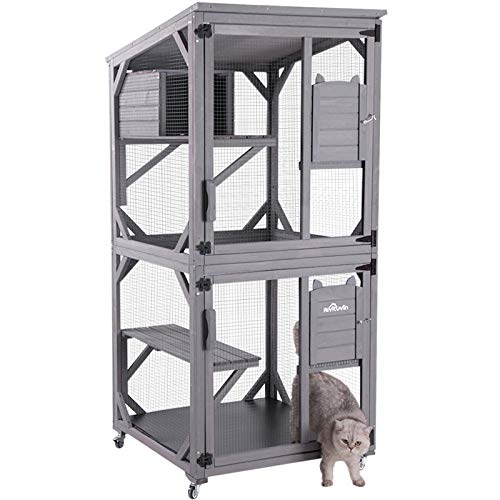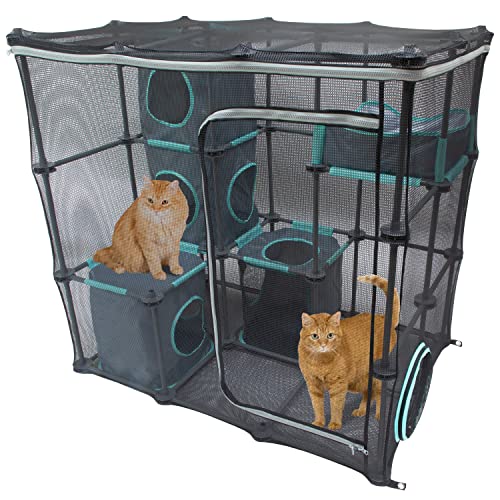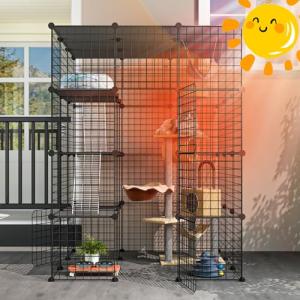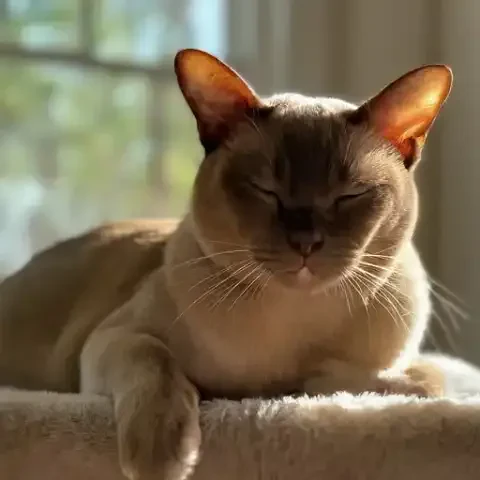Imagine your cat, nose twitching with delightful curiosity, whiskers vibrating with anticipation, taking their first tentative steps beyond the familiar threshold of your doorway and into a brand new world. A world brimming with rustling leaves whispering secrets in the breeze, the heady perfume of fragrant blooms dancing on the air, and the mesmerizing flutter of wings as fascinating insects flit and dance among the greenery. For an indoor cat, the garden isn’t just an outdoor space; it's an undiscovered kingdom, a sensory playground waiting to be explored.
Or perhaps you've noticed your feline companion spending hours gazing longingly through the window, transfixed by the vibrant life unfolding just beyond the glass. Their paws knead restlessly, their tails twitch with suppressed excitement, a clear yearning for the sights, sounds, and scents of the great outdoors. What if you could grant them access to this captivating world, not just as a fleeting glimpse, but as a tangible, safe, and enriching extension of their indoor domain?
Creating a cat-friendly garden isn’t simply about opening the back door and letting your cat roam freely. It's a thoughtful and intentional approach to landscaping, a design philosophy that recognizes and caters to the unique needs and instincts of our feline companions. It's about transforming your outdoor space into a haven where your cat can safely indulge their natural behaviours, explore their senses, and experience the joys of the natural world, all within the secure boundaries of your own backyard.
This article is your compass on this exciting journey, guiding you through the practical steps and inspiring ideas needed to craft a garden that is not only visually stunning for you but also a stimulating, safe, and utterly enjoyable paradise for your cat. We’ll unravel the myriad benefits of a cat-friendly garden, for both your feline friend and yourself, before delving into the essential design elements that form the heart of such a space. From prioritizing safety above all else to incorporating sensory delights and functional features that cater to feline activities, we’ll cover every aspect of creating this outdoor sanctuary. We’ll then move into the practicalities of planning and implementing your cat-friendly garden, from plant selection and building functional elements to ongoing maintenance tips that ensure long-term enjoyment for everyone involved. Prepare to unlock the potential of your garden and transform it into an extension of your cat’s kingdom, a shared space where feline joy blossoms alongside your beautiful blooms.
Why dedicate your time and effort to creating a cat-friendly garden? The answer lies in the profound benefits such a space provides, enriching the lives of both your feline companions and yourself in countless ways. For cats, a well-designed garden is more than just a change of scenery; it’s a transformative experience that taps into their primal instincts and enhances their overall well-being.
Imagine the sensory explosion a garden provides for a creature whose world is often confined to the relatively limited sensory palette of an indoor environment. Outdoors, the air is alive with a symphony of new smells – the earthy aroma of soil, the sweet fragrance of flowers, the pungent scent of herbs, the tantalizing pheromones left by other creatures. Sounds become a chorus of rustling leaves, chirping birds, buzzing insects, and the gentle whisper of the wind. Textures abound, from the cool smoothness of stones to the springy resilience of moss, the rough bark of trees, and the tickle of blades of grass beneath their paws. Sights are no longer limited to the four walls of a room; the garden explodes with vibrant colours, shifting patterns of light and shadow, and the constant motion of life in bloom. This sensory feast is not just stimulating; it’s profoundly enriching for a cat's mind, keeping them engaged, curious, and mentally agile.
Beyond sensory stimulation, a cat-friendly garden provides invaluable opportunities for cats to indulge in their natural behaviours, instincts that are often suppressed or limited in purely indoor environments. Here, they can truly embrace their inner hunter, stalking through long grasses, pouncing on rustling leaves, and chasing after (safe and cat-appropriate) toys in a natural setting. Exploration becomes a real adventure, as they navigate winding paths, investigate hidden corners, and discover the secret lives unfolding amongst the plants. Dust bathing, a natural feline grooming behaviour, becomes a delightful activity in designated sandy patches. Scratching on logs and tree stumps fulfills their innate need to sharpen their claws and mark their territory in a way that’s both natural and garden-appropriate. These are not just playful antics; they are essential expressions of their feline nature, contributing to their physical and psychological well-being.
The garden also becomes an outdoor gymnasium, encouraging exercise and physical activity that can be challenging to replicate indoors. Chasing butterflies (safely!), climbing on low branches, leaping onto rocks, and simply patrolling their outdoor domain all contribute to improved physical fitness, helping to combat boredom and prevent weight gain, a common concern for indoor cats. This physical activity, combined with the mental stimulation of the garden environment, significantly contributes to their mental well-being. A garden provides an outlet for stress and pent-up energy, leading to calmer, more contented cats who are less prone to boredom-related issues like destructive scratching or excessive meowing indoors.
The benefits of a cat-friendly garden ripple outwards, extending beyond your feline companion to enrich your own life as a cat owner. A stimulated and happy cat is, quite simply, a more enjoyable companion. A cat who has had the opportunity to explore, hunt, and engage their senses outdoors is often calmer and more relaxed indoors, leading to a more peaceful and harmonious household. Providing outdoor access, particularly in a thoughtfully designed garden, can significantly reduce indoor boredom-related issues. Cats who have an outlet for their energy and instincts outside are less likely to resort to destructive scratching, furniture climbing, or other undesirable behaviours within the house.
Beyond the direct benefits to your cat, a cat-friendly garden becomes a shared space of enjoyment for both of you. Imagine relaxing in your garden, surrounded by beautiful blooms, while watching your cat contentedly explore, bask in the sun, or playfully stalk a toy amongst the greenery. It’s an opportunity to connect with your cat in a new and enriching way, sharing moments of quiet observation and joyful interaction in a natural setting. And let’s not forget the aesthetic appeal. Cat-friendly elements, when thoughtfully integrated into your garden design, can actually enhance its overall beauty. Natural materials, textured foliage, and strategically placed features can create a garden that is not only functional for felines but also a visually stunning and welcoming outdoor space for human enjoyment.
Creating a truly cat-friendly garden hinges on incorporating key elements that cater to feline needs and instincts, transforming your outdoor space into a haven designed specifically for their enjoyment and well-being. At the heart of this design philosophy lies a single, unwavering principle: safety first, always.
Safety must be the absolute bedrock of your cat-friendly garden design. The primary concern is creating secure boundaries that prevent your cat from wandering beyond the garden’s confines and into potential dangers. Traditional fencing is a starting point, but often insufficient for agile felines. Consider cat-proof fencing extensions – mesh netting or angled barriers that prevent climbing over the top. Netting can also be used to create fully enclosed garden spaces, particularly effective for balconies or patios. For smaller gardens, or if you prefer a less visually intrusive approach, consider specially designed pet containment systems, which may involve buried wires and collar-activated deterrents, though always prioritize positive reinforcement training over purely deterrent methods.
Beyond physical boundaries, garden safety extends to plant selection. A crucial aspect of cat-friendly gardening is diligently researching and avoiding toxic plants and substances. Many common garden plants, while beautiful to us, are poisonous to cats. Lilies, in particular, are notoriously lethal, even in small amounts. Other dangerous plants include azaleas, tulips, daffodils, sago palms, and many more. Thoroughly research any plant before introducing it into your cat garden, consulting reliable lists of toxic and non-toxic plants (ASPCA and Pet Poison Helpline websites are excellent resources). Similarly, avoid using chemical pesticides, herbicides, and fertilizers. Opt for organic gardening methods and pet-safe alternatives for pest control and fertilization.
Water features, while aesthetically pleasing, can pose potential hazards. Ponds or pools, if included, should have shallow edges or escape routes to prevent accidental drowning. Consider using wildlife-friendly ponds with gradual slopes, or cover larger water features with netting when cats are unsupervised. Even bird baths or deep water bowls should be shallow enough for a cat to easily climb out of if they were to fall in.
Finally, shelter from the elements is a critical safety consideration. Just as they need indoor retreats, cats also require shade and protection from sun, rain, and wind in the garden. Ensure there are ample shady spots, whether natural shade provided by trees and shrubs, or constructed shelters like covered beds, tunnels, or even simple cardboard boxes placed in sheltered areas. These shelters provide refuge from harsh weather and offer a sense of security and comfort in the outdoor environment.
With safety firmly established as the foundation, we can then layer in the sensory delights that transform a garden into a feline paradise. Engage your cat's keen senses by incorporating a variety of sensory elements. Fragrant plants are irresistible to cats, turning your garden into an olfactory wonderland. Catnip, catmint, and silvervine are well-known feline favourites, eliciting playful and euphoric responses. But don’t limit yourself to just these classic choices. Lavender, thyme, and valerian also offer appealing scents, while lemon balm and rosemary can add interesting aromatic layers. Plant these fragrant herbs in accessible areas, allowing your cat to brush against them, roll in them, and enjoy their intoxicating aromas.
Textural variety is equally important, creating a tactile landscape for feline exploration. Incorporate different textures throughout the garden. Plant soft, feathery grasses that sway gently in the breeze, offering a delightful rustling sound and a pleasing texture underpaw. Include patches of soft moss, inviting for lounging and gentle paw pads. Scatter smooth stones of varying sizes, offering cool surfaces to rest on and interesting textures to explore. Use bark mulch in planting beds, providing a natural, earthy texture underfoot and suppressing weeds while being safe for cats.
Visual stimulation adds another layer of feline enjoyment. Choose plants that attract butterflies and birds, creating a safe and captivating wildlife show for your cat to observe (ensure bird feeders are placed safely out of reach to prevent predation). Incorporate plants with varying heights, shapes, and colours, creating visual interest and depth in the garden landscape. Plants that move gently in the breeze, like ornamental grasses or bamboo, can also add captivating visual motion, stimulating a cat's hunting instincts. Consider adding sound elements, but keep them gentle and natural. Gentle wind chimes, with soft, melodic tones, can add a subtle auditory layer without being startling or overwhelming. Rustling grasses naturally create soothing sounds as they move in the wind. Avoid loud or sudden noises, which can be stressful for cats and detract from the tranquil garden environment.
Beyond sensory stimulation and safety, a truly cat-friendly garden incorporates functional features that cater directly to a cat’s natural activities and behaviours. Scratching is a non-negotiable feline need, so provide ample natural scratching surfaces. Incorporate logs and tree stumps into your garden design, offering robust and natural scratching outlets that blend seamlessly with the outdoor aesthetic. Purpose-built outdoor scratching posts, made from durable materials like weather-resistant wood and sisal rope, can also be strategically placed throughout the garden.
Dust bathing is a natural grooming behaviour that cats instinctively enjoy. Create designated dust bathing areas by providing patches of loose soil or sand in sunny, sheltered spots. These areas mimic natural dust bathing sites and offer a satisfying grooming experience for your cat. Elevated perches and viewing spots are essential, tapping into a cat’s love for surveying their territory from above. Incorporate rocks of varying heights, tree stumps, or build simple platforms using pavers or repurposed materials. Place these elevated spots in sunny locations for basking and in strategic viewpoints overlooking the garden, offering prime observation points.
Hiding places and retreats are just as crucial outdoors as they are indoors. Create sheltered areas that offer cats a sense of security and privacy. Dense shrubs, planted in clusters, provide natural hiding places and offer a sense of enclosure. Tunnels, made from willow branches, woven structures, or even repurposed drainage pipes, offer fun passageways and sheltered retreats. Covered beds, positioned in sheltered spots, offer comfortable and secure resting areas. For cats who enjoy digging, consider creating designated digging zones. If digging in flowerbeds is a concern, proactively create specific areas where digging is permitted. Use large containers, designated sandboxes, or loose soil patches in out-of-the-way locations to divert digging behaviour away from your prized plants.
With a vision of a safe, stimulating, and functional cat garden in mind, let’s turn to the practicalities of creating your own feline paradise. Garden planning is the crucial first step, ensuring that your cat-friendly vision translates into a harmonious and functional reality. Start by assessing your existing space. Evaluate the size of your garden, noting sunny and shady areas, existing trees, shrubs, and features. Identify any potential hazards, such as unfenced boundaries, toxic plants, or water features that might pose a risk.
Consider zoning your garden, creating distinct areas for different purposes. Designate specific zones primarily for cat activities, such as scratching areas, dust bathing spots, and elevated perches. Create other zones for more traditional gardening, flowerbeds, or human relaxation areas, like patios or seating areas. The key is to allow for overlap and visual harmony between these zones, ensuring the cat-friendly elements blend seamlessly into the overall garden design. Think about integrating cat features in a way that complements your existing garden style and aesthetic. Use natural materials like wood, stone, and bark mulch to create a cohesive and naturalistic look. Blend cat structures into the landscaping by using plants to soften edges, create visual screens, or integrate them into existing garden beds.
Budget and maintenance are crucial practical considerations. Cat-friendly gardens can be created on various budgets. DIY projects, using repurposed materials, and choosing cost-effective plants can create a beautiful garden without breaking the bank. Consider your maintenance commitment. Some cat-friendly features, like dust bathing areas, may require minimal upkeep, while others, like catnip patches, may require occasional pruning to manage spread. Choose plants and features that align with your gardening skill level and available time for maintenance.
Plant selection is at the heart of a thriving cat-friendly garden. Prioritize plants that are both safe and appealing to cats, while also fitting your garden aesthetic and growing conditions. Cat-attracting plants are essential for creating a truly engaging garden for your feline. Catnip, catmint, silvervine, valerian, and cat thyme are all feline magnets, drawing cats into the garden and providing opportunities for playful interaction and sensory enrichment. Lemongrass, with its citrusy aroma, is also often enjoyed by cats. However, be mindful of responsible planting. Catnip, in particular, can be quite vigorous and self-seed readily, so consider planting it in containers or designated areas to manage its spread.
Alongside cat-attracting plants, select a variety of beautiful, non-toxic plants to create a visually appealing and safe garden. Herbs like basil, parsley, and oregano are not only safe for cats but can also add fragrance and culinary interest to your garden. Grasses, especially ornamental grasses, provide texture, movement, and safe chewing options for cats. Sunflowers, with their towering height and bright blooms, add visual drama and are non-toxic. Impatiens and snapdragons offer vibrant colours and are also safe choices for a cat garden. Crucially, always prioritize safety by creating a “plants to avoid” list. Become familiar with common toxic plants and diligently avoid including them in your cat garden. Lilies, azaleas, tulips, daffodils, sago palms, oleander, and castor bean are just a few examples of plants that should be strictly excluded. Always double-check plant safety using reliable online resources or by consulting with your local garden centre or veterinarian.
Container gardening and raised beds offer invaluable flexibility and control in a cat-friendly garden. Containers allow you to grow cat-attracting plants in specific locations, managing their spread and preventing them from overwhelming other plants. Raised beds offer better drainage and soil control, particularly useful for creating designated dust bathing areas or planting cat-friendly herbs. Containers and raised beds also elevate plants, potentially making them slightly less accessible to digging cats, and add visual height and structure to the garden design.
Building functional features can be a rewarding DIY aspect of creating your cat-friendly garden. Simple scratching posts can be crafted from logs or sturdy branches, securely anchored in the ground or placed in heavy bases. Dust bathing areas are easily created by simply clearing a patch of soil and amending it with sand or fine gravel in a sunny location. Simple shelters can be constructed using wooden boxes, terracotta pots turned on their side, or even repurposed storage containers, providing inexpensive yet effective retreats. Elevated platforms can be fashioned from bricks, pavers, or repurposed wooden planks, creating simple yet functional viewing and basking spots. If you choose to incorporate water features, prioritize safety. Shallow dishes of water are ideal for drinking and offer minimal risk. If you desire a larger water feature like a pond, ensure it is safely fenced or netted to prevent unsupervised access and potential accidents.
Once your cat-friendly garden is established, ongoing maintenance is key to ensuring its long-term enjoyment and safety for both you and your feline companion. Regular safety checks are essential. Periodically inspect fencing to ensure it remains secure and intact, preventing escapes. Remove any toxic plants that may have inadvertently self-seeded or been introduced by birds or wind. Check for and eliminate any potential hazards, such as sharp objects, exposed wires, or toxic substances that may have found their way into the garden.
Plant maintenance is an ongoing task. Prune cat-attracting plants, like catnip and catmint, as needed to manage their growth and prevent them from becoming too sprawling. Replace plants as they age or become damaged. Manage self-seeding plants, like catnip, to prevent them from overtaking desired areas of the garden, thinning them out as necessary to maintain balance. Hygiene and cleanliness are important, particularly if you choose to place a litter box outdoors within the garden (for outdoor-access cats). Regularly scoop and clean outdoor litter boxes to prevent odours and maintain hygiene. Remove any pet waste promptly from the garden to maintain cleanliness and prevent parasites. General garden hygiene, including weeding and removing debris, helps to maintain a healthy and safe environment for both your plants and your cat.
Finally, observe your cat’s garden habits. Pay attention to how your cat uses the garden. Do they favour certain scratching posts over others? Do they prefer sunny basking spots or shady retreats? Which plants do they gravitate towards? Adapt your garden elements based on your cat’s individual preferences. If they aren’t using a particular feature, try repositioning it or offering an alternative. Continual observation and adaptation will ensure that your cat-friendly garden remains a dynamic and engaging space that truly caters to your feline companion's needs and desires, evolving with their preferences and providing years of shared outdoor joy.
Creating a cat-friendly garden is an act of love, a commitment to enriching your cat’s life by extending their world beyond the confines of your home and into the sensory delights of the natural world. It's about crafting a space that is not only visually beautiful and enjoyable for you but also a haven of stimulation, safety, and feline-focused fun for your beloved companion. So, step outside, assess your space, and let your imagination bloom alongside your garden. Start planning, start planting, and start building your cat-friendly oasis today. By creating a cat-friendly garden, you’re not just enhancing your outdoor space; you’re enriching your cat’s life, strengthening your bond, and creating a shared haven of joy and connection that will blossom and flourish for years to come.







